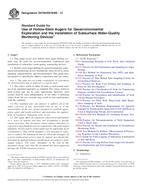Potřebujeme váš souhlas k využití jednotlivých dat, aby se vám mimo jiné mohly ukazovat informace týkající se vašich zájmů. Souhlas udělíte kliknutím na tlačítko „OK“.
ASTM D5784/D5784M-13
Standard Guide for Use of Hollow-Stem Augers for Geoenvironmental Exploration and the Installation of Subsurface Water-Quality Monitoring Devices
Automaticky přeložený název:
Standardní průvodce pro použití Hollow-Stem vrtáky pro Geoenvironmental průzkum a instalace podpovrchových vod, kontroly kvality zařízení
NORMA vydána dne 1.8.2013
Informace o normě:
Označení normy: ASTM D5784/D5784M-13
Poznámka: NEPLATNÁ
Datum vydání normy: 1.8.2013
Kód zboží: NS-32534
Počet stran: 7
Přibližná hmotnost: 21 g (0.05 liber)
Země: Americká technická norma
Kategorie: Technické normy ASTM
Kategorie - podobné normy:
Anotace textu normy ASTM D5784/D5784M-13 :
Keywords:
drilling, geoenvironmental exploration, groundwater, vadose zone, ICS Number Code 13.060.10 (Water of natural resources)
Doplňující informace
| Significance and Use | ||||||||||||||||||||||||||||||
|
4.1 Hollow-stem auger drilling may be used in support of geoenvironmental exploration (Practice D3550, Test Method D4428/D4428M) and for installation of subsurface water-quality monitoring devices in unconsolidated materials. Hollow-stem auger drilling may be selected over other methods based on the advantages over other methods. These advantages include: the ability to drill without the addition of drilling fluid(s) to the subsurface, and hole stability for sampling purposes (see Test Method D1586 and Practices D1587, D2487, D2488, and D6151) and monitor-well construction in unconsolidated to poorly indurated materials. This drilling method is generally restricted to the drilling of shallow, unconsolidated materials or softer rocks. The hollow-stem drilling method is a favorable method to be used for obtaining cores and samples and for the installation of monitoring devices in many, but not all geologic environments. 4.1.1 The application of hollow-stem
augers to geoenvironmental exploration may involve groundwater and
soil sampling, in-situ or pore-fluid testing, or utilization of the
hollow-auger column as a casing for subsequent drilling activities
in unconsolidated or consolidated materials (Test Method
D2113).
4.1.2 The hollow-stem auger column
may be used as a temporary casing for installation of a subsurface
water-quality monitoring device. The monitoring device is usually
installed as the hollow-auger column is removed from the
borehole.
4.2 The subsurface water-quality monitoring devices that are addressed in this guide consist generally of a screened or porous intake device and riser pipe(s) that are usually installed with a filter pack to enhance the longevity of the intake unit, and with isolation seals and low-permeability backfill to deter the movement of fluids or infiltration of surface water between hydrologic units penetrated by the borehole (see Practice D5092). Inasmuch as a piezometer is primarily a device used for measuring subsurface hydraulic heads, the conversion of a piezometer to a water-quality monitoring device should be made only after consideration of the overall quality and integrity of the installation, to include the quality of materials that will contact sampled water or gas. 1.1 This guide covers how
hollow-stem auger-drilling systems may be used for geoenvironmental
exploration and installation of subsurface water-quality monitoring
devices.
1.2 Hollow-stem auger drilling for geoenvironmental exploration and monitoring device installations often involves safety planning, administration, and documentation. This guide does not purport to specifically address exploration and site safety. 1.3 The values stated in either SI
units or inch-pound units are to be regarded separately as
standard. The values stated in each system may not be exact
equivalents; therefore, each system shall be used independently of
the other. Combining values from the two systems may result in
non-conformance with the standard.
1.4 This standard does not purport to address all of the safety concerns, if any, associated with its use. It is the responsibility of the user of this standard to establish appropriate safety and health practices and determine the applicability of regulatory limitations prior to use. 1.5 This guide offers an organized collection of information or a series of options and does not recommend a specific course of action. This document cannot replace education or experience and should be used in conjunction with professional judgment. Not all aspects of this guide may be applicable in all circumstances. This ASTM standard is not intended to represent or replace the standard of care by which the adequacy of a given professional service must be judged, nor should this document be applied without consideration of a project's many unique aspects. The word “Standard” in the title of this document means only that the document has been approved through the ASTM consensus process. |
||||||||||||||||||||||||||||||
| 2. Referenced Documents | ||||||||||||||||||||||||||||||
|
Doporučujeme:
Aktualizace zákonů
Chcete mít jistotu o platnosti užívaných předpisů?
Nabízíme Vám řešení, abyste mohli používat stále platné (aktuální) legislativní předpisy.
Chcete vědět více informací? Podívejte se na tuto stránku.




 Cookies
Cookies
